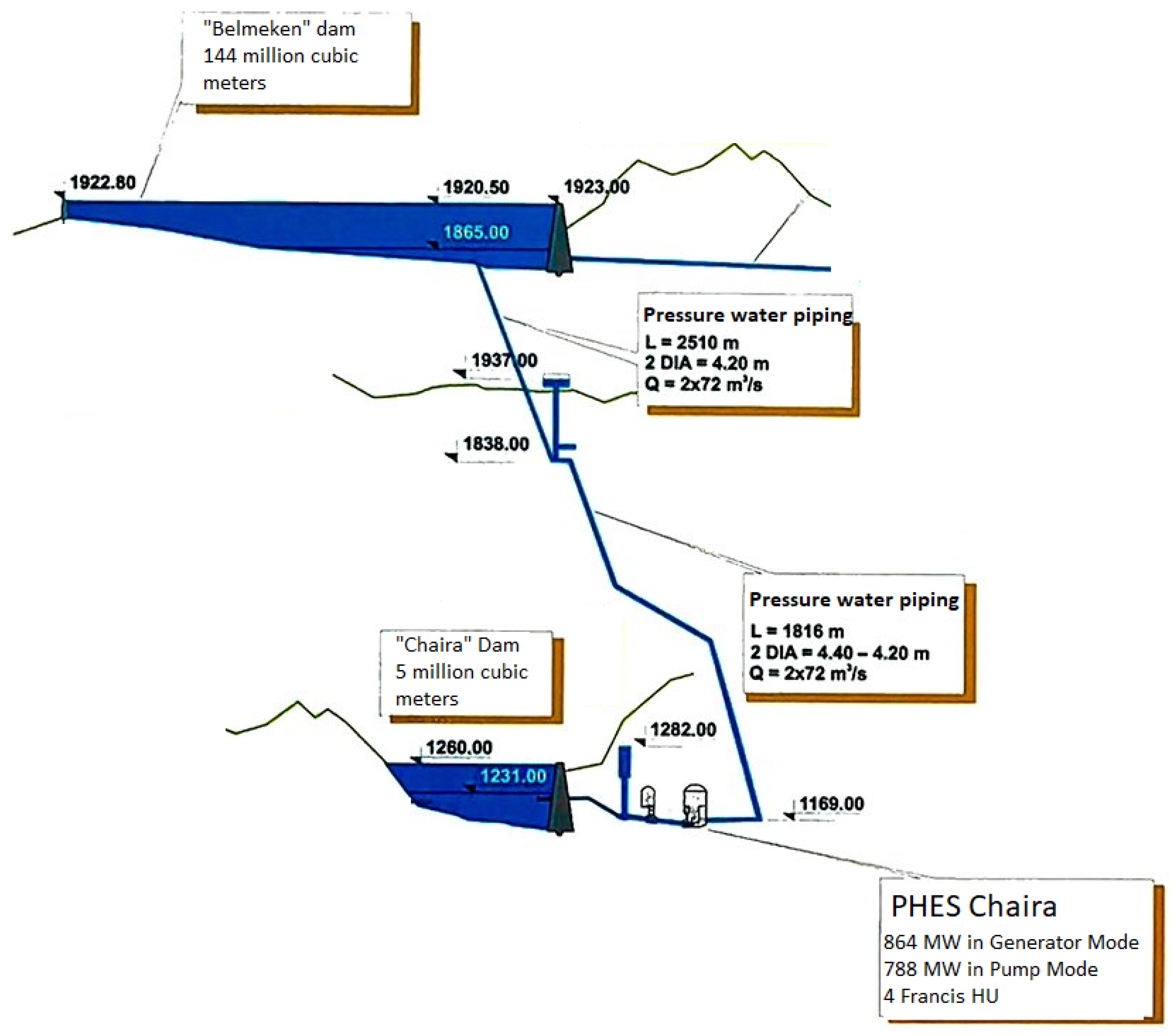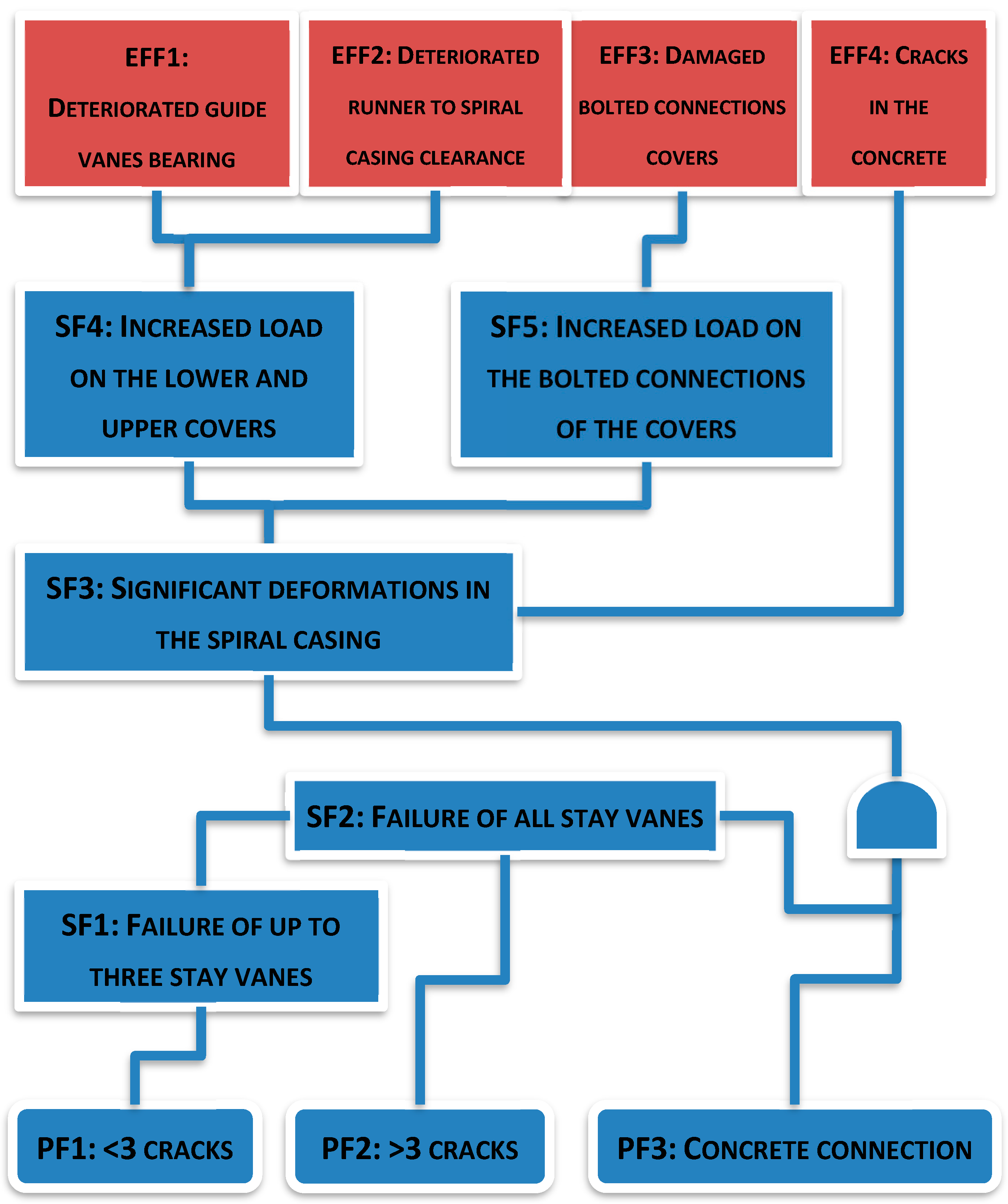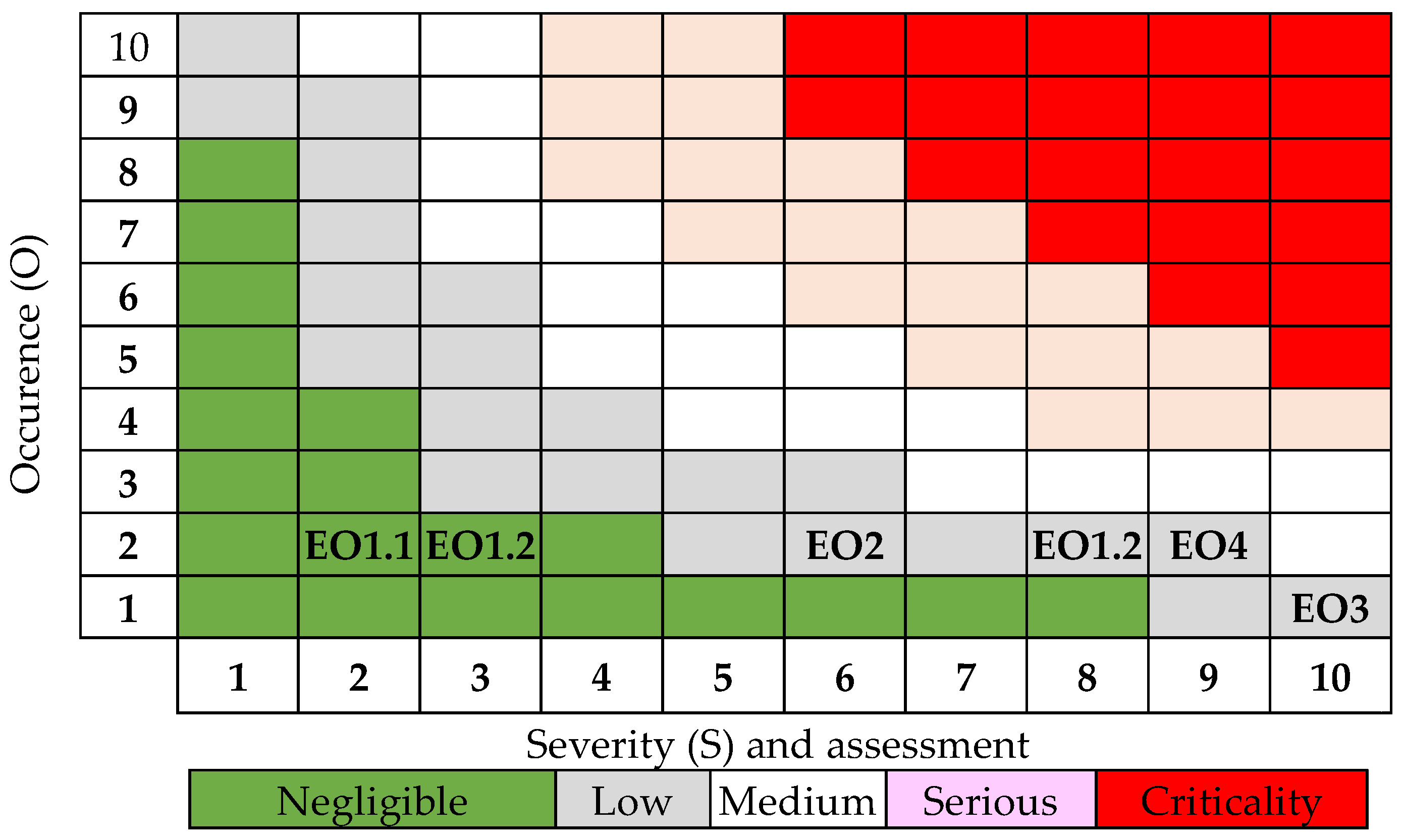Failure Modes and Effect Analysis of Turbine Units of Pumped Hydro-Energy Storage Systems
Abstract
1. Introduction
2. Materials and Methods
2.1. Risk Analysis: Essence
- B: 1–4: Categories for security-related parts of controls;
- N: Normal category for the risk level
- (N): Additional directions for standard solutions for protection devices and electronical devices (this category can generally be accomplished by using electronics);
- +: Deviation to an upper category;
- −: Deviation to a lower category.
- (S): Grade of the possible injury:
- (F): Frequency of the incidence:
- (P): Possibility of risk prevention:
2.2. Methodology Used for the Analysis of Failures and Their Effects
- S—severity (criticality)—assesses the degree of significance of a failure;
- O—occurrence (failure intensity)—assesses the likely occurrence of such a failure;
- D—detection (detectability)—represents the probability of detecting the cause of a failure.
- RPN values up to 40 indicate low risk (no need for corrective actions);
- RPN values in the range 40 ÷ 100 indicate moderate risk (certain actions are needed to improve the study object);
- RPN values above 100 are classified as unacceptable risk (urgent actions are needed).
3. Results
Fault Tree Analysis of HU3 of PHES “Chaira”
- Primary failure (failure of a component under normal operating conditions);
- Secondary failure (failure of a component as a result of secondary failure from a primary failure or as a result of extreme operating conditions);
- Errors as a result of incorrect operation or misuse.
- Primary failures/shutting out (PFs):
- ○
- PF1: Crack formation on the faces of up to three stay vanes due to low-cycle material fatigue;
- ○
- PF2: Crack formation on the faces of more than three stay vanes due to low-cycle material fatigue;
- ○
- PF3: The violation of the bond between concrete and spiral casing, leading to a backlash.
- Secondary failures/shutting out (SFs):
- ○
- SF1: The failure of up to three stay vanes;
- ○
- SF2: The failure of all stay vanes;
- ○
- SF3: Significant deformations in the spiral casing;
- ○
- SF4: Increased load on the lower and upper covers;
- ○
- SF5: Increased load on the bolted connections of the covers due to their overloading by bending moment.
- Effects of failures (EFFs):
- ○
- EFF1: Deteriorated guide vane bearings—the violation of clearance and coaxiality occurs between the guide vanes and the bearings, leading to difficulty closing (switching off) the vane control;
- ○
- EFF2: Deteriorated runner to spiral casing clearance—the violation of clearance between the runner and the spiral casing and possible mutual contact;
- ○
- EFF3: Damaged bolted connections of covers—the destruction of bolted connections of the covers due to their overloading by bending moment;
- ○
- EFF4: Cracks in the concrete—the cracking of the concrete due to the overloading of the spiral casing and the total failure of the stay vanes.
4. Discussion
5. Conclusions
- Regular inspection and planned repairs be to provided.
- Units that cannot be surveyed visually must be equipped with sensors and control devices; these are the following:
- ○
- The guide vanes and their welding places;
- ○
- The water ingress in the bearings;
- ○
- The gap between the concrete and the spiral casing;
- ○
- The deflections of the bolts of the upper and lower covers;
- ○
- The stresses in the spiral casing.
- Monitoring for water ingress into the drainage holes should be organized.These measures and additional equipment will allow for the timely detection and prediction of failures.
Author Contributions
Funding
Data Availability Statement
Conflicts of Interest
References
- Available online: https://www.nek.bg/index.php/en/ (accessed on 5 January 2025).
- Available online: https://wwtech.com.pl/en/2024/09/11/chaira-pump-storage-hpp-bulgaria/ (accessed on 1 April 2025).
- Available online: https://balkangreenenergynews.com/bulgaria-to-replace-broken-turbines-in-chaira-pumped-storage-hydropower-plant/ (accessed on 5 January 2025).
- Available online: https://en.wikipedia.org/wiki/List_of_hydroelectric_power_station_failures (accessed on 1 April 2025).
- Yasuda, M.; Watanabe, S. How to Avoid Severe Incidents at Hydropower Plants. Int. J. Fluid Mach. Syst. 2017, 10, 296–306. [Google Scholar] [CrossRef]
- Available online: https://en.wikipedia.org/wiki/Sayano-Shushenskaya_power_station_accident (accessed on 1 April 2025).
- Nicolet, C.; Avellan, F.; Allenbach, P.; Sapin, A.; Simond, J.-J. New Tool for the Simulation of Transient Phenomena in Francis Turbine Power Plants. In Proceedings of the Hydraulic Machinery and Systems, 21st IAHR Symposium, Lausanne, Switzerland, 9–12 September 2002; Available online: https://www.powervision-eng.ch/Profile/Publications/pdf/IAHR_2002.pdf (accessed on 1 April 2025).
- Available online: https://www.hydropower.org/sediment-management-case-studies/nepal-kali-gandaki (accessed on 1 April 2025).
- Aliabadi; Jam, F.; Ghahremani, H. Crack Formation on Francis Runners for Karun III Hydroelectric Project: Causes and Solutions. In Proceedings of the 1st International and 3rd National Conference on Dams and Hydropower, Tehran, Iran, 8–13 February 2012; Available online: https://civilica.com/doc/138473/ (accessed on 1 April 2025).
- Alvarez, A. Solving a Problem Related to Shear Pin Failure. Hydro Review 2011. Available online: https://www.hydroreview.com/world-regions/latin-america/solving-a-problem-related-to-shear/ (accessed on 1 April 2025).
- Halipchuk, P.; Penner, K.; Smith, S. Machining Solutions: Repairing Cracked Turbine Shafts at Jenpeg. HydroWorld.com. Available online: https://www.renewableenergyworld.com/baseload/hydropower/machining-solutions-repairing-cracked-turbine-shafts-at-jenpeg/ (accessed on 1 April 2025).
- Price, J.W.H. The failure of the Dartmouth turbine casing. Int. J. Press. Vessel. Pip. 1998, 75, 559–566. [Google Scholar] [CrossRef]
- Gao, X.; Fu, D.; Wu, H. Embedment of Steel Spiral Casings in Concrete: Lessons from a Structural Deformation Accident in China. Appl. Sci. 2022, 12, 8395. [Google Scholar] [CrossRef]
- Ma, Z.; Zhang, C. Static and dynamic damage analysis of mass concrete in hydropower house of Three Gorges Project. Trans. Tianjin Univ. 2010, 16, 433–440. [Google Scholar] [CrossRef]
- Todorov, G.; Kralov, I.; Kamberov, K.; Sofronov, Y.; Zlatev, B. Failure mechanisms of stay vanes in a PHES Francis turbine unit. In Proceedings of the 13th International Scientific Conference “TechSys 2024”—Engineering, Technologies and Systems, Plovdiv, Bulgaria, 18 May 2024. [Google Scholar]
- Todorov, G.; Kralov, I.; Kamberov, K.; Zahariev, E.; Sofronov, Y.; Zlatev, B. An Assessment of the Embedding of Francis Turbines for Pumped Hydraulic Energy Storage. Water 2024, 16, 2252. [Google Scholar] [CrossRef]
- Todorov, G.; Kralov, I.; Kamberov, K.; Sofronov, Y.; Zlatev, B.; Zahariev, E. Investigation and Identification of the Causes of the Unprecedented Accident at the “Chaira” Pumped Hydroelectric Energy Storage. Water 2024, 16, 3393. [Google Scholar] [CrossRef]
- Hanel, B. FKM-Guideline. In Analytical Strength Assessment of Components in Mechanical Engineering; VDMA Verlag GmbH: Frankfurt, Germany, 2003. [Google Scholar]
- Chryssanthopoulos, M.; Righiniotis, T. Fatigue reliability of welded steel structures. J. Constr. Steel Res. 2006, 62, 1199–1209. [Google Scholar] [CrossRef]
- Liu, X.; Luo, Y.; Wang, Z. A review on fatigue damage mechanism in hydro turbines. Renew. Sustain. Energy Rev. 2016, 54, 1–14. [Google Scholar] [CrossRef]
- Lyutov, A.; Kryukov, A.; Cherny, S.; Chirkov, D.; Salienko, A.; Skorospelov, V.; Turuk, P. Modeling of a Francis Turbine Runner Fatigue Failure Process Caused by Fluid-Structure Interaction. IOP Conf. Ser. Earth Environ. Sci. 2016, 49, 072012. [Google Scholar] [CrossRef]
- Presas, A.; Luo, Y.; Wang, Z.; Guo, B. Fatigue life estimation of Francis turbines based on experimental strain measurements: Review of the actual data and future trends. Renew. Sustain. Energy Rev. 2019, 102, 96–110. [Google Scholar] [CrossRef]
- Biner, D.; Alligné, S.; Nicolet, C.; Dujic, D.; Münch-Alligné, C. Numerical fatigue damage analysis of a variable speed Francis pump-turbine during start-up in generating mode. In IOP Conference Series: Earth and Environmental Science; IOP Publishing: Bristol, UK, 2022; Volume 1079, p. 012079. Available online: https://iopscience.iop.org/article/10.1088/1755-1315/1079/1/012079 (accessed on 1 April 2025).
- Zhang, Q.-L.; Hu, L.; Gao, X.-F. Fatigue life prediction of steel spiral cases in pumped-storage power plants: Factors to be considered. Eng. Fail. Anal. 2024, 157, 107908. [Google Scholar] [CrossRef]
- Souza, R.Q.; Álvares, A.J. FMEA and FTA Analysis for Application of the Reliability Centered Maintenance Methodology: Case Study on Hydraulic Turbines. ABCM Symposium Series in Mechatronics. 2008; Volume 3, pp. 803–812. Available online: https://www.abcm.org.br/symposium-series/SSM_Vol3/Section_VII_Emerging_Technologies_and_Applications/SSM3_VII_10.pdf (accessed on 1 April 2025).
- Peeters, J.F.W.; Basten, R.J.I.; Tinga, T. Improving failure analysis efficiency by combining FTA and FMEA in a recursive manner. Reliab. Eng. Syst. Saf. 2018, 172, 36–44. [Google Scholar] [CrossRef]
- InfraSpeak Team. FTA vs FMEA: What Are the Differences? 23 October 2020. Available online: https://blog.infraspeak.com/fta-vs-fmea/ (accessed on 1 April 2025).
- Standard: DIN EN ISO 12100:2011-03, Safety of Machinery—General Principles for Design—Risk Assessment and Risk Reduction, Publication Date 2011-03, Original Language German, Pages 96. Available online: https://www.dinmedia.de/en/standard/din-en-iso-12100/128264334 (accessed on 1 April 2025).
- Flynn, A.M. Hazard Risk Assessment, Chapter in the Book. In Introduction to Environmental Management, 2nd ed.; Theodore, M.K., Theodore, L., Eds.; CRC Press: Boca Raton, FL, USA, 2021; pp. 1–11. Available online: https://www.taylorfrancis.com/chapters/edit/10.1201/9781003171126-44/hazard-risk-assessment-ann-marie-flynn (accessed on 1 April 2025).
- TheSafetyMaster. Hazard Identification and Risk Assessment; Study Report Consultancy and Training Services; TheSafetyMaster: Gurugram, India, 2024; Available online: https://www.thesafetymaster.com/hazard-identification-and-risk-assessment-study-report-consultancy-and-training-services-by-thesafetymaster/ (accessed on 1 April 2025).
- Standard DIN EN ISO 14121-1:2007-12 Safety of Machinery—Risk Assessment—Part 1: Principles (ISO 14121-1:2007); German Version Sicherheit von Maschinen—Risikobeurteilung—Teil, Pages 35. Available online: https://www.dinmedia.de/en/standard/din-en-iso-14121-1/94405328 (accessed on 1 April 2025).
- Quality-One International. Introduction to Failure Mode, Effects & Criticality Analysis (FMECA). Available online: https://quality-one.com/fmeca/ (accessed on 1 April 2025).
- Military Handbook. Reliability Prediction of Electronic Equipment. 1991. Available online: https://www.navsea.navy.mil/Portals/103/Documents/NSWC_Crane/SD-18/Test%20Methods/MILHDBK217.pdf (accessed on 1 April 2025).
- Rausand, M.; Haugen, S. Risk Assessment: Theory, Methods, and Applications, 2nd ed.; Wiley: Hoboken, NJ, USA, 2020; ISBN 978-1-119-37722-1. [Google Scholar]







| Level | Description | Rating (S) |
|---|---|---|
| None | No effect on components | 1 |
| Minor | Minor effect on the system | 2 |
| Very low | Slightly pronounced impact on the system | 3 |
| Low | Low level of criticality regarding the functioning of the system | 4 |
| Average | The system is functioning, albeit with broken parameters | 5 |
| High | Reduced system functionality | 6 |
| Very high | Loss of important system functions | 7 |
| Dangerous | Functions are lost, leading to potential danger to users | 8 |
| Very dangerous | Potentially dangerous system condition, with indications allowing preventive action | 9 |
| Extremely dangerous | System condition with possible critical impacts on personnel, albeit without possibility of detection and prevention | 10 |
| Intensity | Probability | Rating (O) |
|---|---|---|
| Extremely low | ≤1 × 10−5 | 1 |
| Low | 1 × 10−4 | 2 |
| Average grade | 5 × 10−4 | 3 |
| 1 × 10−3 | 4 | |
| 2 × 10−3 | 5 | |
| High degree (repeatability) | 5 × 10−3 | 6 |
| 1 × 10−2 | 7 | |
| 2 × 10−2 | 8 | |
| 5 × 10−2 | 9 | |
| Very high degree | ≥1 × 10−1 | 10 |
| Grade | Description | Rating (D) |
|---|---|---|
| Very high | Very high probability of failure detection | 1 |
| High | High probability of failure detection | 2 |
| Relatively high | Relatively high probability of failure detection | 3 |
| Medium | Average probability of detecting failure | 4 |
| Relatively low | Relatively low probability of detecting the potential cause/mechanism of failure | 5 |
| Low | Low probability of detecting the potential cause/mechanism of failure | 6 |
| Very low | Very low probability of detecting the potential cause/mechanism of failure | 7 |
| Weak | Weak probability of detecting the potential cause/mechanism of failure | 8 |
| Very weak | Very weak probability of detecting the potential cause/mechanism of failure | 9 |
| Impossible | Inability to establish the failure | 10 |
| Effect of Refusal | Mode | Effect | Mark |
|---|---|---|---|
| EO1: The violation of the clearance and alignment between the guide vanes and bearings, leading to difficult or no control | P1/P2/ | Strong vibrations in the structure; Water appearing in the service area through drainage holes in the stay vanes. | EO1.1 |
| G1/G2 | Strong vibrations in the structure; Water appearing in the service area through drainage holes in the stay vanes; Difficulty closing the water flow and switching off the machine | EO1.2 | |
| A1 | Strong vibrations in the structure; Water appearing in the service area through drainage holes in the stay vanes; A rapid increase in the machine rotation frequency and danger of exceeding critical ones, leading to destruction; Serious damage to the electrical part of the system | EO1.3 | |
| EO2: The violation of the clearance between the runner and the spiral casing and contact | G1/G2/P1/P2/A1 | Strong impacts on the structure; Water in the service area; The risk of the destruction of the runner bearing; Possible mechanical damage to the spiral casing and the runner | EO2 |
| EO3: The destruction of bolted connections of the covers due to overloading by bending moment | G1/G2/P1/P2/A1 | Strong impacts on the structure; Massive water ingress into the engine room; Difficult or impossible to close the guide vanes | EO3 |
| EO4: The cracking of the concrete due to the overloading of the spiral casing and broken integrity of the stay vanes | G1/G2/P1/P2/A1 | Severe deformations in the structure; Difficult or impossible to close the guide vanes Danger of the destruction of the runner bearing; Serious damages to the electrical part of the system | EO4 |
| Failure Effect | Severity (S) | Occurence (O) | Detection (D) | RPN |
|---|---|---|---|---|
| EO1.1 | 2 | 2 | 6 | 24 |
| EO1.2 | 3 | 2 | 6 | 36 |
| EO1.3 | 8 | 2 | 2 | 32 |
| EO2 | 6 | 2 | 1 | 12 |
| EO3 | 10 | 1 | 2 | 20 |
| EO4 | 9 | 2 | 1 | 18 |
Disclaimer/Publisher’s Note: The statements, opinions and data contained in all publications are solely those of the individual author(s) and contributor(s) and not of MDPI and/or the editor(s). MDPI and/or the editor(s) disclaim responsibility for any injury to people or property resulting from any ideas, methods, instructions or products referred to in the content. |
© 2025 by the authors. Licensee MDPI, Basel, Switzerland. This article is an open access article distributed under the terms and conditions of the Creative Commons Attribution (CC BY) license (https://creativecommons.org/licenses/by/4.0/).
Share and Cite
Todorov, G.; Kralov, I.; Kamberov, K.; Sofronov, Y.; Zlatev, B.; Zahariev, E. Failure Modes and Effect Analysis of Turbine Units of Pumped Hydro-Energy Storage Systems. Energies 2025, 18, 1885. https://doi.org/10.3390/en18081885
Todorov G, Kralov I, Kamberov K, Sofronov Y, Zlatev B, Zahariev E. Failure Modes and Effect Analysis of Turbine Units of Pumped Hydro-Energy Storage Systems. Energies. 2025; 18(8):1885. https://doi.org/10.3390/en18081885
Chicago/Turabian StyleTodorov, Georgi, Ivan Kralov, Konstantin Kamberov, Yavor Sofronov, Blagovest Zlatev, and Evtim Zahariev. 2025. "Failure Modes and Effect Analysis of Turbine Units of Pumped Hydro-Energy Storage Systems" Energies 18, no. 8: 1885. https://doi.org/10.3390/en18081885
APA StyleTodorov, G., Kralov, I., Kamberov, K., Sofronov, Y., Zlatev, B., & Zahariev, E. (2025). Failure Modes and Effect Analysis of Turbine Units of Pumped Hydro-Energy Storage Systems. Energies, 18(8), 1885. https://doi.org/10.3390/en18081885






